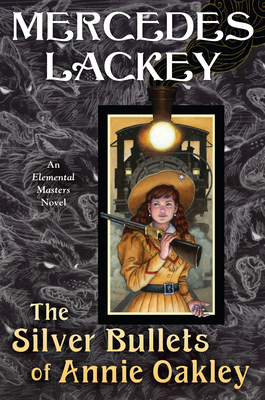 The Silver Bullets of Annie Oakley (Elemental Masters, #16) by Mercedes Lackey
The Silver Bullets of Annie Oakley (Elemental Masters, #16) by Mercedes Lackey Format: eARC
Source: supplied by publisher via Edelweiss
Formats available: hardcover, paperback, ebook
Genres: alternate history, fantasy, gaslamp, historical fantasy, steampunk
Series: Elemental Masters #16
Pages: 320
Published by DAW Books on January 11, 2022
Purchasing Info: Author's Website, Publisher's Website, Amazon, Barnes & Noble, Kobo, Bookshop.org
Goodreads
The sixteenth novel in the magical alternate history Elemental Masters series follows sharpshooter Annie Oakley as she tours Europe and discovers untapped powers.
Annie Oakley has always suspected there is something "uncanny" about herself, but has never been able to put a name to it. But when Buffalo Bill's Wild West Show goes on tour through Germany, Bill temporarily hires a new sharpshooter to be part of his "World Wide Congress of Rough Riders": a woman named Giselle, who also happens to be an Elemental Master of Air. Alongside this new performer, Annie discovers that she and her husband, Frank, are not simply master marksman, but also magicians of rare ability.
As they travel and perform, Annie must use her newfound knowledge and rare skill to combat creatures of the night scattered across the countryside, who threaten both the performers and the locals. Annie's got her gun, and it's filled with silver bullets.
My Review:
When I read the first few books in the Elemental Masters series – as they came out back in the early 2000s – I loved these retellings of classic fairy tales set in an alternate, slightly steampunkish late Victorian/early Edwardian era for the way that they mixed a bit of magic with a bit of alternate history to put a fresh face on a tale that was oh-so-familiar.
Now that I’m thinking about this the series is an alternate version of another of Lackey’s alternate ways of telling fairy tales, her Five Hundred Kingdoms series (begin with The Fairy Godmother) where the purpose of the story was to subvert the fairy tale to keep it from subverting someone’s life.
I digress.
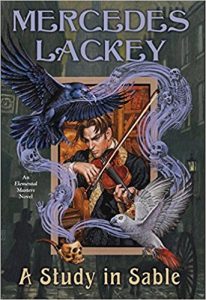 I stopped reading the Elemental Masters series after Reserved for the Cat as a consequence of the “so many books, so little time” conundrum that all of us who live in books are faced with so often. But I came back when the series switched from fairy tales to legendary characters with A Study in Sable and the three books that followed (A Scandal in Battersea, The Bartered Brides and The Case of the Spellbound Child) because the legendary character that was introduced and followed in this subseries of the series was none other than Sherlock Holmes.
I stopped reading the Elemental Masters series after Reserved for the Cat as a consequence of the “so many books, so little time” conundrum that all of us who live in books are faced with so often. But I came back when the series switched from fairy tales to legendary characters with A Study in Sable and the three books that followed (A Scandal in Battersea, The Bartered Brides and The Case of the Spellbound Child) because the legendary character that was introduced and followed in this subseries of the series was none other than Sherlock Holmes.
I can never resist a Holmes pastiche, and these were no exception.
But after following the “World’s Greatest Consulting Detective”, even an alternate version thereof, through an alternate version of Holmes’ London, the series took itself across the pond to the Americas while briefly turning to its roots of retelling fairy tales with Jolene. Which I have yet to read – even though just the title is giving me an earworm of Dolly Parton’s marvelous song – which I’m sure was the intention.
I was, however, all in to read this latest book in the series, The Silver Bullets of Annie Oakley, because I was wondering how the author would blend this historical character into this world where magic is hidden just beneath the surface.
It turns out that Annie Oakley herself, the real one, provided her own introduction to this world. As this story opens, we’re with Annie as she is in contracted servitude to a married couple she only refers to as “the Wolves” in her diary. Her real, historical diary.
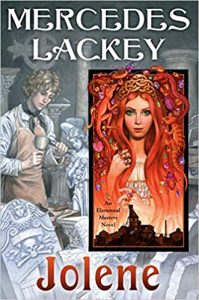 The Wolves – whose identity has never been conclusively determined – starved her, cheated her, threatened her and physically and mentally abused her at every turn for two years, beginning when Annie was nine years old.
The Wolves – whose identity has never been conclusively determined – starved her, cheated her, threatened her and physically and mentally abused her at every turn for two years, beginning when Annie was nine years old.
In this story, those two years of hell on earth become Annie’s introduction to the magic of this alternate world. Not just because the people she calls “the Wolves” turn out to be actual wolves – or rather werewolves – but because her desperate escape from the Wolves is facilitated by the magic of this alternate world – both the magic of the fairies AND magic of Annie’s very own.
After that shocking and heartbreaking beginning, the story shifts to Annie Oakley as an adult, the star of Buffalo Bill’s Wild West show, traveling in Europe.
Where she discovers that her childhood rescue by fairies was not the fever dream she tried to convince herself that it was. And that the magic she has hidden from herself all these years is hers to command – if she is willing to learn.
And that she’ll need all the training and assistance that she can get. Because the wolves are still after her.
Escape Rating A-: When I was growing up – back in the Dark Ages – there weren’t nearly enough biographies of women in my elementary school library. Honestly, there weren’t nearly enough, period. While there still aren’t, the situation has improved at least a bit.

One of the few that was always available was Annie Oakley. It was easy to find stuff about her, and as someone who read as much of that library as humanly possible, I found what there was. She’s a fascinating person, as a woman in the late 19th and early 20th century who was famous for what she herself DID, and not for who she married, who she killed (I’m looking at you, Lizzie Borden) or who or what she was victimized by. Nor was she famous for her beauty. (I’ve included a picture to let you judge for yourself on that score, but whether you like her looks or not they are not what made her famous.
Her ability to shoot a gun, accurately and at a distance, is what made her famous. It also put food on the table when she was young and her family was broke.
Blending her real history and real talents into this magical story, and keeping reasonably close to what is known about her while expanding it into this created world was fascinating and fun. This was also a terrific story to get new readers into this long running series, as Annie is an adult when she finds out that she has magic, and her training in her newly discovered powers helps the reader get on board with the way that this world works AND is fascinating in its own right.
So this story’s blend of history with magic just plain worked for me – even more than I expected it to. More than enough to make me not miss the Sherlock Holmes of the earlier stories in the series too much.
Obviously, I really enjoyed this particular entry in this long-running series. MORE than enough that I’ll be back the next time the author returns to it. In the meantime, I have plenty of entries in the series that I missed to dip into whenever I’m looking for this blend of magic, myth and history.

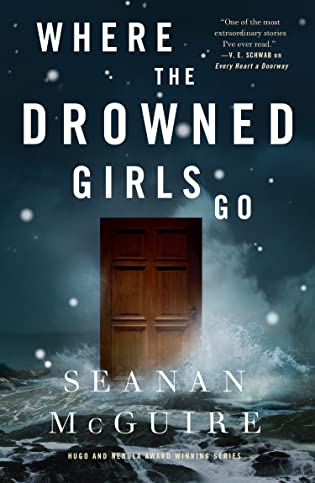 Where the Drowned Girls Go (Wayward Children, #7) by
Where the Drowned Girls Go (Wayward Children, #7) by  We were introduced to Eleanor West’s Home for Wayward Children in the first book in this series,
We were introduced to Eleanor West’s Home for Wayward Children in the first book in this series,  Cora Miller, whom we met in
Cora Miller, whom we met in 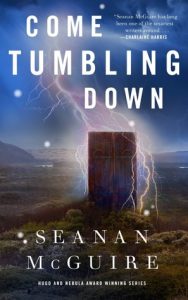 She’s already internalized the messages for girls to be “girly”, flirty and tiny and weak and thin, and has a lot of self-hatred because she’s none of the above. The Whitethorn Institute encourages the children in its dubious “care” to show the worst of themselves, so Cora is bullied and teased for being different – in addition to everything else that’s wrong at Whitethorn.
She’s already internalized the messages for girls to be “girly”, flirty and tiny and weak and thin, and has a lot of self-hatred because she’s none of the above. The Whitethorn Institute encourages the children in its dubious “care” to show the worst of themselves, so Cora is bullied and teased for being different – in addition to everything else that’s wrong at Whitethorn. While this particular entry in the series turned out to be an unexpected readalike for
While this particular entry in the series turned out to be an unexpected readalike for 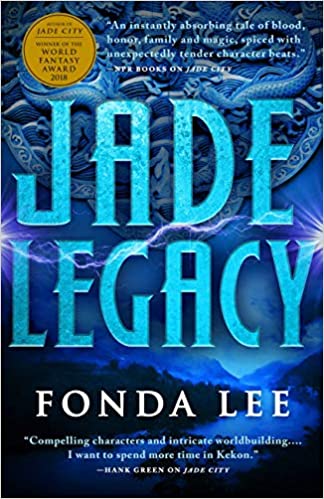 Jade Legacy (The Green Bone Saga, #3) by
Jade Legacy (The Green Bone Saga, #3) by 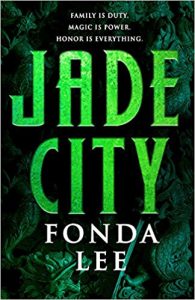 The story that began in
The story that began in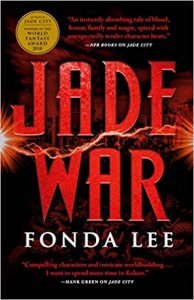 Escape Rating A++: This book, and this entire series, deserve all the stars. I picked this to be the last review of the year because I wanted to finish this year’s reading with a real bang of a winner, and Jade Legacy delivered all the highs and lows I could possibly have ever wanted.
Escape Rating A++: This book, and this entire series, deserve all the stars. I picked this to be the last review of the year because I wanted to finish this year’s reading with a real bang of a winner, and Jade Legacy delivered all the highs and lows I could possibly have ever wanted.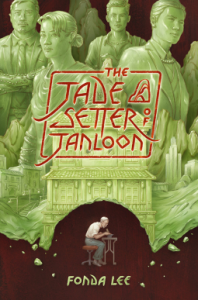 Watching them rise, and fall, and rise again is a journey very worth taking. If you have not yet had the pleasure, start with Jade City and be prepared for a wild, satisfying and heartbreaking ride. I envy you the journey.
Watching them rise, and fall, and rise again is a journey very worth taking. If you have not yet had the pleasure, start with Jade City and be prepared for a wild, satisfying and heartbreaking ride. I envy you the journey.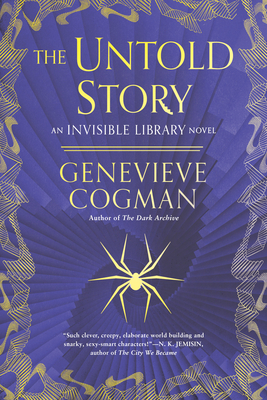 The Untold Story (The Invisible Library #8) by
The Untold Story (The Invisible Library #8) by 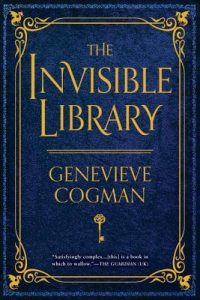 This final book in the Invisible Library series closes at the open. When we first met Irene Winters all the way back in the first book, also titled
This final book in the Invisible Library series closes at the open. When we first met Irene Winters all the way back in the first book, also titled 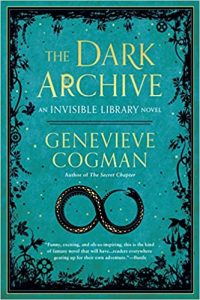 While this series has been very much one caper after another, the lighthearted tone of the series has slipped towards a more serious turn as it has continued. After Irene’s discovery at the end of the previous book,
While this series has been very much one caper after another, the lighthearted tone of the series has slipped towards a more serious turn as it has continued. After Irene’s discovery at the end of the previous book,  Boundaries (Tales of Valdemar #15) by
Boundaries (Tales of Valdemar #15) by 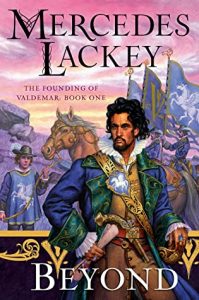 After reading – and loving –
After reading – and loving – 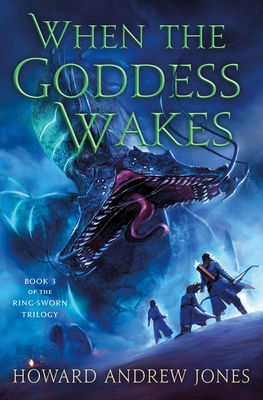 When the Goddess Wakes (The Ring-Sworn Trilogy, #3) by
When the Goddess Wakes (The Ring-Sworn Trilogy, #3) by 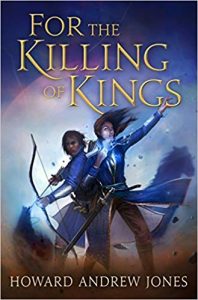 In other words, the ending of
In other words, the ending of 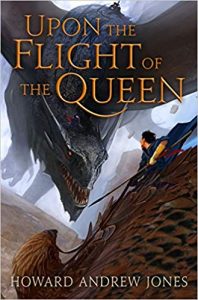 The enemy of my enemy may not exactly be my friend, but when my enemy plans to destroy the entire world including both the enemy of my enemy and myself – and every other person, animal, place and thing in that entire world, the enemy of my enemy and I – or in this case the Altenerai, and the Naor, are more or less united in the face of the alternative.
The enemy of my enemy may not exactly be my friend, but when my enemy plans to destroy the entire world including both the enemy of my enemy and myself – and every other person, animal, place and thing in that entire world, the enemy of my enemy and I – or in this case the Altenerai, and the Naor, are more or less united in the face of the alternative.
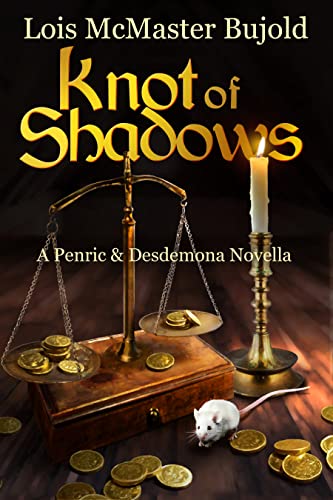 Knot of Shadows (Penric & Desdemona #11) by
Knot of Shadows (Penric & Desdemona #11) by 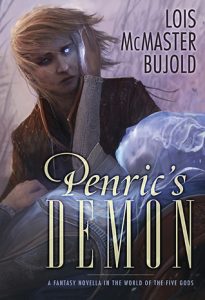 There’s a fine line between justice and vengeance. In the World of the Five Gods, that line is the white of the Fifth God, the Lord Bastard, the god of chaos, criminals and unexpected blessings, often of the “may you live in interesting times” and “be careful what you wish for” varieties. The Bastard is the god that Learned Penric, sorcerer and divine, serves in whatever way his god deems best – or whatever way will screw up Penric’s life the most at the time. If the White God has his way – and he usually does – it’s generally both at once.
There’s a fine line between justice and vengeance. In the World of the Five Gods, that line is the white of the Fifth God, the Lord Bastard, the god of chaos, criminals and unexpected blessings, often of the “may you live in interesting times” and “be careful what you wish for” varieties. The Bastard is the god that Learned Penric, sorcerer and divine, serves in whatever way his god deems best – or whatever way will screw up Penric’s life the most at the time. If the White God has his way – and he usually does – it’s generally both at once.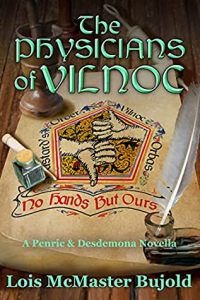 Escape Rating A-: OMG this was the right book at the right time. Last week’s reading ended on a major fail, so I was looking for something that I was even more certain would be a terrific read. I was also looking for a story of people being competent and accepted for their competence, as Penric finally has been. (He needed to grow up first, and he has.) What I especially loved about this entry in the series is that it’s both a puzzle to be solved AND displays the way that things in this world WORK, both in the sense of how things are done as well as in the way that justice is finally served. The way that even though human justice failed, divine justice was able to balance the scales.
Escape Rating A-: OMG this was the right book at the right time. Last week’s reading ended on a major fail, so I was looking for something that I was even more certain would be a terrific read. I was also looking for a story of people being competent and accepted for their competence, as Penric finally has been. (He needed to grow up first, and he has.) What I especially loved about this entry in the series is that it’s both a puzzle to be solved AND displays the way that things in this world WORK, both in the sense of how things are done as well as in the way that justice is finally served. The way that even though human justice failed, divine justice was able to balance the scales.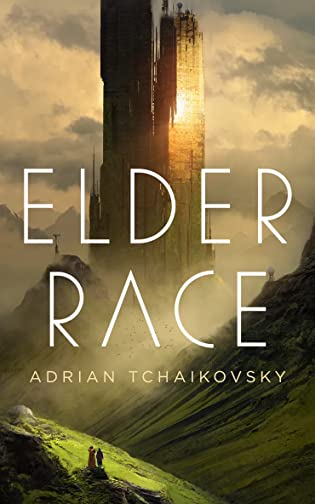 Elder Race by
Elder Race by 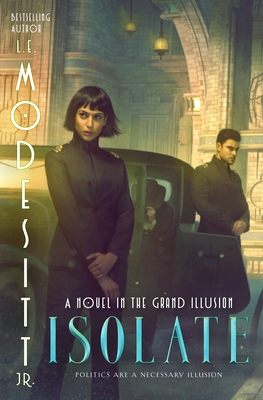 Isolate (The Grand Illusion #1) by
Isolate (The Grand Illusion #1) by 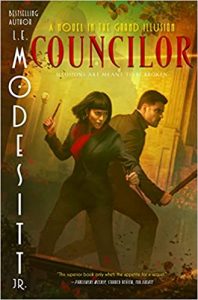 Instead, it ends up being the story of three people doing the best that they can to help their country in spite of everyone who tries to get in their way. In the process, they all rise above the place they expected to be, and that’s just the kind of story I love to sink into.
Instead, it ends up being the story of three people doing the best that they can to help their country in spite of everyone who tries to get in their way. In the process, they all rise above the place they expected to be, and that’s just the kind of story I love to sink into.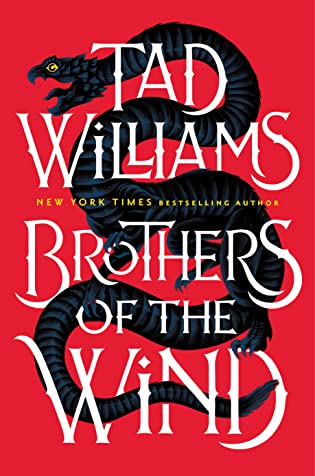 Brothers of the Wind by
Brothers of the Wind by 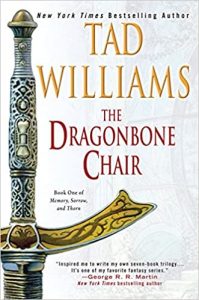 It’s hard to believe that
It’s hard to believe that 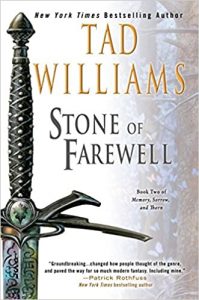 Escape Rating A-: More than anything else, Brothers of the Wind is a story about overweening pride going before a very big fall. And it’s a story about the difference between pride and honor. It’s also, playing into that pride, a story about the braying of privilege and the horrifying results of its exercise.
Escape Rating A-: More than anything else, Brothers of the Wind is a story about overweening pride going before a very big fall. And it’s a story about the difference between pride and honor. It’s also, playing into that pride, a story about the braying of privilege and the horrifying results of its exercise.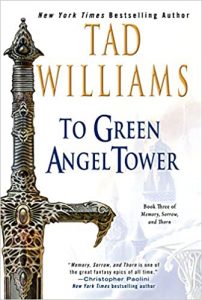 But this isn’t just the story of the two brothers, because the perspective of the story is told by Hakatri’s faithful servant, Pamon Kes. While Brothers of the Wind isn’t quite as epic as The Lord of the Rings, The Dragonbone Chair and the whole of Memory, Sorrow and Thorn definitely are. Which means that this book reads very much as if The Lord of the Rings had been written by Sam Gamgee entirely from his first-person perspective. A perspective that shows that even the compassionate, golden Hakatri took a tremendous amount of advantage of the goodwill and hero worship of an awful lot of people, whether his motives were pure or not.
But this isn’t just the story of the two brothers, because the perspective of the story is told by Hakatri’s faithful servant, Pamon Kes. While Brothers of the Wind isn’t quite as epic as The Lord of the Rings, The Dragonbone Chair and the whole of Memory, Sorrow and Thorn definitely are. Which means that this book reads very much as if The Lord of the Rings had been written by Sam Gamgee entirely from his first-person perspective. A perspective that shows that even the compassionate, golden Hakatri took a tremendous amount of advantage of the goodwill and hero worship of an awful lot of people, whether his motives were pure or not.